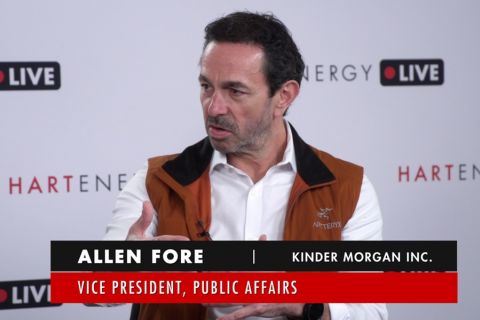Learn more about Hart Energy Conferences
Get our latest conference schedules, updates and insights straight to your inbox.
Shale production has made North America the envy of the world, and the revolution has staying power that will not vanish within the next few years, according to ConocoPhillips Chief Executive Ryan Lance.
Speaking during the recent Deloitte Oil and Gas Conference in Houston, Lance said shale production in the U.S. and Canada has increased 37% since 2005 and continues to grow.
The production surge has led to 33 proposed export terminals in North America, multibillion-dollar projects predicated on low natural gas prices continuing. Lance said later that global demand and competing supplies will, however, restrict the number of projects that are actually built. The global demand is projected to only grow about 30 billion cubic feet (Bcf) per day by 2025, while the export capacity for the proposed projects is about 45 Bcf per day.
“Supply and demand is going to play a key role in determining which of these projects move forward,” he added. There are other sources of growth fueling this energy renaissance. Gulf of Mexico (GoM) deepwater production doubled during the 1990s, flattened out, and is rising again.
“There is a new tranche of production startups that have been announced that are coming on, and new areas are yielding fairly large discoveries whether we’re talking about the Miocene, the Paleogene (lower Tertiary), the Pliocene, even the Jurassic, or the subsalt that is going on in the GoM,” Lance said.
The U.S. has already surpassed other countries in terms of gas production, becoming the world’s No. 1 producer at about 65 Bcf per day. The U.S. also is on track to pass Russia this year in total oil and gas production and is predicted to pass Saudi Arabia in the next few years, he added.
“We can export energy to our allies now. We have a greater diplomatic influence in the world today,” Lance said. “With this rising supply in self sufficiency, it weakens some of the more hostile producers that might want to hold us hostage.”
But there are some challenges. These, Lance said, include weak demand in North America resulting in low prices, infrastructure permitting delays, import/export issues, public concern about hydraulic fracturing, oil and gas workers approaching retirement age and costly regulations.
Then, there are technology challenges and critical water issues. Lance said the industry has made a lot of progress in this area and continues looking for ways to reduce water usage.
Added to that are the issues of water management and how to reuse water to make quality fluids and continue stimulating the wellbore, he continued. He predicts a lot of subsurface advances will be forthcoming over the next five to 10 years as the industry works to get the ultimate recovery from investments.
“I think we’re in the first inning of this unconventional story,” Lance said.
Recommended Reading
The Jones Act: An Old Law on a Voyage to Nowhere
2024-04-12 - Keeping up with the Jones Act is a burden for the energy industry, but efforts to repeal the 104-year-old law may be dead in the water.
Kinder Morgan Exec: Building Pipelines ‘Challenging, but Manageable’
2024-04-05 - Allen Fore, vice president of public affairs for Kinder Morgan, said building anything, from a new road to an ice cream shop, can be tough but dealing with stakeholders up front can move projects along.
BOEM Adjusts Monetary Penalties for Oil, Gas Companies
2024-01-25 - BOEM’s adjustment is based on a 2015 act that requires annual inflation adjustments.
SEC Targets SPACs with New, Enhanced Disclosure Rules
2024-01-25 - SPAC IPOs and de-SPAC combinations became a popular means for private companies to access the public markets during the pandemic. Regulators aim to make the SPAC process closer to a traditional IPO.
US Companies Ponder Future in Venezuela as Washington Pressures Maduro on Elections
2024-01-26 - The pressure is on again for Venezuela’s President Nicolás Maduro to announce a clear election timeline amid tensions following recent arrest orders and detentions of his opposition supporters.





